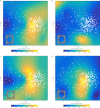Functional and ecomorphological evolution of orbit shape in mesozoic archosaurs is driven by body size and diet
- PMID: 35953708
- PMCID: PMC9372157
- DOI: 10.1038/s42003-022-03706-0
Functional and ecomorphological evolution of orbit shape in mesozoic archosaurs is driven by body size and diet
Abstract
The orbit is one of several skull openings in the archosauromorph skull. Intuitively, it could be assumed that orbit shape would closely approximate the shape and size of the eyeball resulting in a predominantly circular morphology. However, a quantification of orbit shape across Archosauromorpha using a geometric morphometric approach demonstrates a large morphological diversity despite the fact that the majority of species retained a circular orbit. This morphological diversity is nearly exclusively driven by large (skull length > 1000 mm) and carnivorous species in all studied archosauromorph groups, but particularly prominently in theropod dinosaurs. While circular orbit shapes are retained in most herbivores and smaller species, as well as in juveniles and early ontogenetic stages, large carnivores adopted elliptical and keyhole-shaped orbits. Biomechanical modelling using finite element analysis reveals that these morphologies are beneficial in mitigating and dissipating feeding-induced stresses without additional reinforcement of the bony structure of the skull.
© 2022. The Author(s).
Conflict of interest statement
The author declares no competing interests.
Figures








Similar articles
-
The evolution of cranial form and function in theropod dinosaurs: insights from geometric morphometrics.J Evol Biol. 2012 Feb;25(2):365-77. doi: 10.1111/j.1420-9101.2011.02427.x. Epub 2011 Nov 24. J Evol Biol. 2012. PMID: 22111918
-
Nocturnality in dinosaurs inferred from scleral ring and orbit morphology.Science. 2011 May 6;332(6030):705-8. doi: 10.1126/science.1200043. Epub 2011 Apr 14. Science. 2011. PMID: 21493820
-
Jaw shape and mechanical advantage are indicative of diet in Mesozoic mammals.Commun Biol. 2021 Feb 23;4(1):242. doi: 10.1038/s42003-021-01757-3. Commun Biol. 2021. PMID: 33623117 Free PMC article.
-
Biology of the sauropod dinosaurs: the evolution of gigantism.Biol Rev Camb Philos Soc. 2011 Feb;86(1):117-55. doi: 10.1111/j.1469-185X.2010.00137.x. Biol Rev Camb Philos Soc. 2011. PMID: 21251189 Free PMC article. Review.
-
How Triceratops got its face: An update on the functional evolution of the ceratopsian head.Anat Rec (Hoboken). 2023 Jul;306(7):1951-1968. doi: 10.1002/ar.25196. Epub 2023 Mar 8. Anat Rec (Hoboken). 2023. PMID: 36883781 Review.
Cited by
-
Morphological disparity and structural performance of the dromaeosaurid skull informs ecology and evolutionary history.BMC Ecol Evol. 2024 Apr 16;24(1):39. doi: 10.1186/s12862-024-02222-5. BMC Ecol Evol. 2024. PMID: 38622512 Free PMC article.
-
Estimation of maximum body size in fossil species: A case study using Tyrannosaurus rex.Ecol Evol. 2024 Jul 24;14(7):e11658. doi: 10.1002/ece3.11658. eCollection 2024 Jul. Ecol Evol. 2024. PMID: 39050661 Free PMC article.
-
Cranial functional specialisation for strength precedes morphological evolution in Oviraptorosauria.Commun Biol. 2024 Apr 10;7(1):436. doi: 10.1038/s42003-024-06137-1. Commun Biol. 2024. PMID: 38600295 Free PMC article.
References
-
- Witmer LM. The evolution of the antorbital cavity of archosaurs: a study in soft-tissue reconstruction in the fossil record with an analysis of the function of pneumaticity. J. Vertebrate Paleontol. 1997;17:1–76. doi: 10.1080/02724634.1997.10011027. - DOI
-
- Rayfield EJ, Milner AC. Establishing a framework for archosaur cranial mechanics. Paleobiology. 2008;34:494–515. doi: 10.1666/07006.1. - DOI
MeSH terms
Associated data
LinkOut - more resources
Full Text Sources

